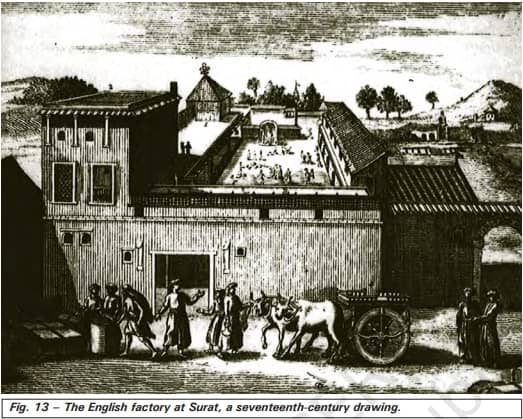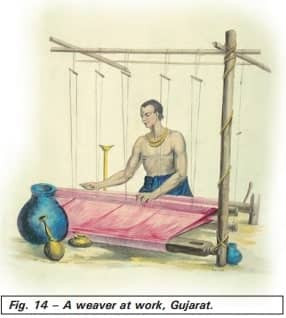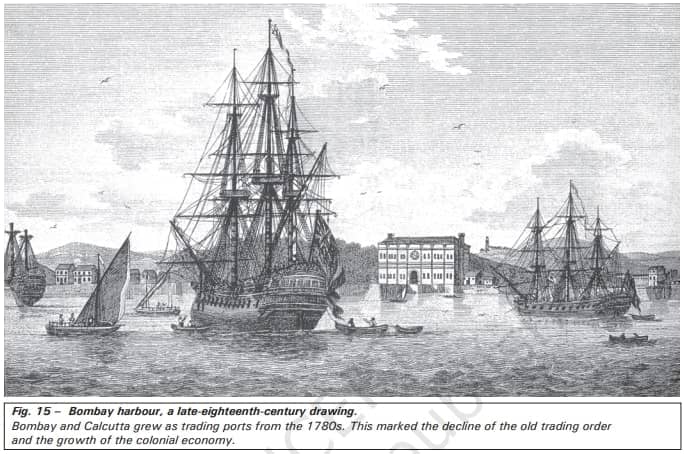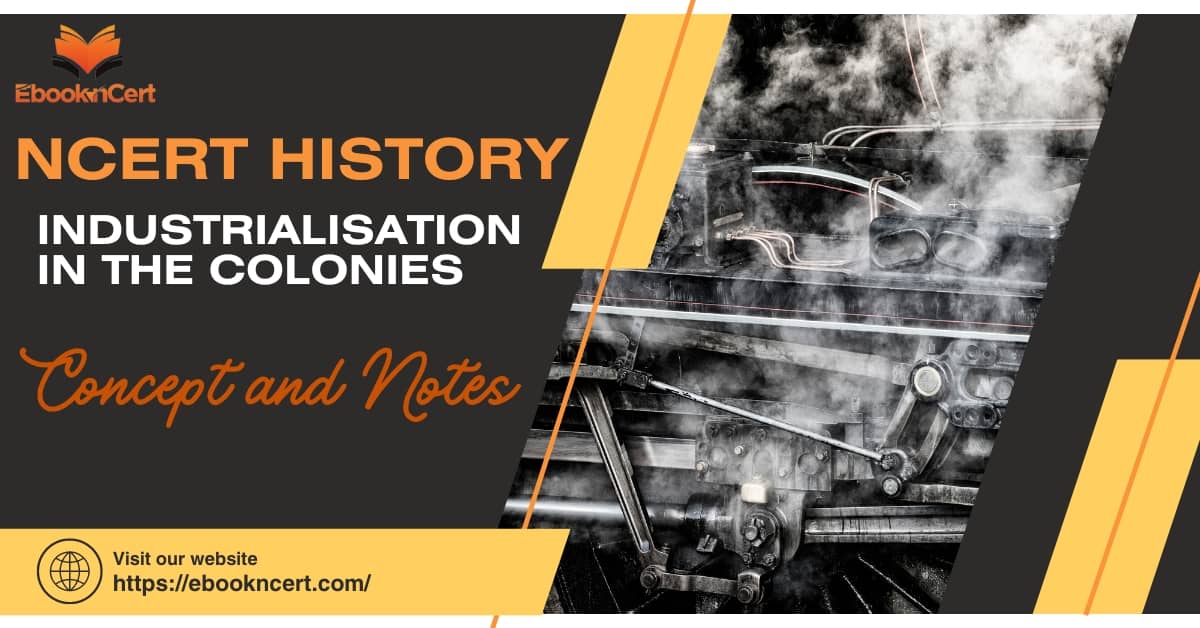NCERT History Class 10 | Industrialisation in the Colonies – Concept and Notes
Topic & sub-topics covered: Industrialisation in the Colonies, The Age of Indian Textiles, What Happened to Weavers?, Manchester Comes to India: The Age of Industrialisation (All single detail notes are exam-oriented).
We have discussed in-depth and exam-oriented pointers that can be asked in the board exam of class 10th about “Industrialisation in the Colonies, The Age of Indian Textiles, What Happened to Weavers?, Manchester Comes to India” which is taken from the NCERT History book for class 10th chapter no. 4 “The Age of Industrialisation“.
Download NCERT History Chapter 4 Class 10th Notes PDF for The Age of Industrialisation
If you are in class 10th and looking for free NCERT History chapter 4 notes of the chapter The Age of Industrialisation class 10 that cover concepts, then you can download the free class 10th History chapter 4 notes “The Age of Industrialisation”. You should download this free PDF for future test or exam preparations.
Industrialisation in the Colonies
1. Focus on India’s Industrialization:
- Shifting focus to India to explore the industrialization process in a colony.
- Examining both factory industries and the non-mechanised sector for a comprehensive understanding.
The Age of Indian Textiles

1. Pre-Machine Industry Dominance:
- Highlighting India’s historical dominance in the international textile market before the age of machine industries.
2. Silk and Cotton Goods:
- India’s specialization in the production of silk and high-quality cotton goods for international trade.
3. Trade Routes and Networks:
- Description of the extensive trade routes, including overland routes through mountain passes and sea trade through key pre-colonial ports.
4. Role of Merchants and Bankers:
- Examining the vital role played by Indian merchants and bankers in facilitating the export trade network.
5. Breakdown of Indian Merchant Network:
- Discussing the breakdown of the traditional Indian merchant network by the 1750s.
6. European Companies’ Rise to Power:
- Exploring how European companies gradually gained power, securing concessions and monopoly rights, leading to a decline in the influence of Indian merchants.
7. Impact on Old Ports:
- Examining the impact of European ascendancy on traditional ports like Surat and Hoogly, including the dramatic fall in exports and bankruptcy of local bankers.
8. Shift to New Ports:
- Highlighting the shift from old ports to new ones, such as Bombay and Calcutta, as an indicator of the growing influence of colonial powers.
9. Control by European Companies:
- Explaining the transformation of trade dynamics with European companies gaining control, using European ships for transportation.
10. Survival Strategies for Merchants:
- Describing the survival strategies for merchants who had to adapt to operate within the network shaped by European trading companies.
Question: How did these changes affect the life of weavers and other artisans?
Answer: The changes in the textile trade dynamics profoundly affected the lives of weavers and other artisans in India:
- Economic Disruption: The decline of traditional ports like Surat and Hoogly led to economic disruption for weavers. The dramatic fall in exports and bankruptcy of local bankers meant a loss of financial support.
- Loss of Market Access: Weavers faced a loss of direct market access as European companies gained control over the trade. The shift to new ports, controlled by Europeans, limited opportunities for local artisans to independently engage in international trade.
- Dependency on European Networks: With the breakdown of the traditional Indian merchant network, weavers became dependent on European-controlled networks. This shift altered the power dynamics, placing weavers at the mercy of European trading companies.
- Impact on Livelihoods: Weavers and artisans, who were once connected to vibrant inland supply networks, saw a decline in opportunities. The loss of credit from bankrupt bankers and the changing trade routes impacted their ability to sustain their livelihoods.
- Survival Challenges: Weavers faced challenges in adapting to the new order dominated by European companies. They had to navigate through a system where survival strategies often meant aligning with the interests and demands of the European-controlled trade network.
- Competition and Technology: The increased influence of European companies introduced competition and technological changes. Weavers had to contend with the pressures of producing goods that aligned with European preferences and standards.
- Shift in Artisan Power: The shift to new ports, controlled by European powers, signalled a broader shift in the power dynamics. Artisans found themselves in a subordinate position, relying on European companies for market access and facing challenges in preserving their traditional modes of production.
What Happened to Weavers?

1. East India Company and Textile Exports:
- After consolidating power post-1760s, East India Company prioritized the expansion of textile exports from India.
2. Challenges in Pre-1760s:
- Before political dominance, the Company faced challenges in securing a regular supply of goods due to competition from French, Dutch, Portuguese, and local traders.
3. Establishment of Monopoly:
- After acquiring political power, the Company asserted a monopoly right to trade, aiming to eliminate competition, control costs, and ensure regular supplies.
4. Management and Control Measures:
- Implemented a system to directly control weavers, appointing paid servants called gomasthas to supervise production, collect supplies, and examine cloth quality.
5. Elimination of Traders and Brokers:
- Tried to eliminate existing traders and brokers, establishing direct control over weavers to streamline the production and supply process.
6. Advance System and Weavers:
- Used the advance system, providing loans to weavers for raw materials, but in return, weavers were restricted from dealing with other buyers.
7. Impact on Weavers’ Livelihoods:
- Many weavers eagerly took advances, leasing out their land to focus solely on weaving. However, clashes with gomasthas and loss of bargaining power led to dissatisfaction.
8. Migration and Revolts:
- In response to harsh treatment, weavers deserted villages, migrated to set up looms in areas with family connections. In some regions, weavers and village traders revolted against the Company.
9. Consequences for Weavers:
- Weavers faced miserably low prices for their products, and the loans tied them to the Company. Many began refusing loans, closing workshops, and turning to agricultural labor.
10. Transformation by 19th Century:
- By the 19th century, cotton weavers encountered new challenges, reflecting the significant impact of the East India Company’s control on their livelihoods.
Manchester Comes to India

1. Contrast with 1772 Prediction:
- Henry Patullo’s 1772 prediction about the perpetual demand for Indian textiles proved inaccurate as the 19th century witnessed a significant decline in textile exports.
2. Export Statistics Shift:
- In 1811-12, piece-goods constituted 33% of India’s exports, contrasting sharply with 1850-51 when it plummeted to a mere 3%.
3. Impact of English Cotton Industries:
- The rise of cotton industries in England triggered concerns among industrial groups about foreign competition, leading to the imposition of import duties on cotton textiles.
4. Pressure on the Indian Market:
- Industrialists pressurized the government to sell British manufactures in Indian markets, leading to a dramatic increase in exports of British cotton goods in the early 19th century.
5. Rapid Increase in Imports:
- By 1850, cotton piece goods from Britain constituted over 31% of Indian imports, surging to over 50% by the 1870s, demonstrating the dominance of Manchester imports.
6. Dual Challenges for Indian Weavers:
- Indian cotton weavers faced a dual challenge: the collapse of the export market and the inundation of the local market with cheap Manchester imports.
7. Competition with Machine-Produced Goods:
- The imported cotton goods from Manchester, produced by machines at lower costs, flooded the Indian market, making it challenging for local weavers to compete due to the cheap prices.
8. Reports of Decline and Desolation:
- By the 1850s, reports from various weaving regions in India depicted stories of economic decline and desolation among the weavers.
9. Raw Cotton Supply Issues:
- In the 1860s, weavers faced a new challenge as they struggled to obtain a sufficient supply of good-quality raw cotton due to increased demand and the American Civil War.
10. Impact of American Civil War:
- The American Civil War led to increased demand for raw cotton from India. However, this surge in demand resulted in a significant increase in raw cotton prices, adversely affecting Indian weavers.
11. Financial Unsustainability of Weaving:
- The combination of high raw cotton prices and competition from cheap imports made weaving financially unsustainable for Indian weavers by the 1860s.
12. Late 19th Century Challenge:
- Weavers and craftspeople encountered a new challenge by the end of the 19th century.
Question: How could weaving industries possibly survive?
Answer: Weaving industries faced severe challenges to survival in the late 19th century due to the emergence of factories flooding the market with machine-made goods.
To survive, weaving industries needed to adapt and find strategies such as:
- Skill Enhancement: Weavers could focus on enhancing their traditional skills to produce high-quality and intricate handwoven products that machines couldn’t replicate easily.
- Diversification of Products: Weaving communities might diversify their products, creating unique and specialized items that catered to specific markets or niche consumer preferences.
- Artisanal and Handcrafted Appeal: Emphasizing the artisanal and handcrafted nature of their products could attract consumers who appreciated the craftsmanship and uniqueness of handmade textiles.
- Market Differentiation: Weavers could explore niche markets or collaborate with designers to create distinctive products that stood out from mass-produced machine goods.
- Community Support and Marketing: Building community support and effective marketing strategies could help in creating awareness about the value and cultural significance of handwoven textiles.
- Adopting Efficient Practices: Implementing efficient weaving practices and incorporating technological advancements on a smaller scale might improve productivity without compromising traditional craftsmanship.
Survival, in this context, would involve a strategic blend of preserving traditional skills, embracing innovation, and finding unique market positions in the face of industrial competition.
Next & Previous Topics of NCERT/CBSE History Class 10 Chapter 4: The Age of Industrialisation
FAQ
Q1. What is the definition of industrialisation in the colonies?
Answer: Industrialisation in the Colonies refers to the process of applying non-human energy and the factory system to the production of goods in the colonies during the 1840s to 1960s. This period was characterized by the rise of export substitution industrialisation (ESI), which involved adding value to agricultural and mineral products before export.
The process of industrialisation in the colonies was driven by the need to increase productivity and efficiency in the production of goods for the international market. The use of steam power and the factory system allowed for the mass production of consumer goods, which contributed to the growth of industries and the expansion of international trade.
Q2. What were the major challenges faced by industrialisation in the colonies?
Answer: The major economic benefits of industrialization in the colonies include:
- Increased productivity: The use of steam power and factory systems allowed for mass production of goods, leading to increased productivity and efficiency in the production process.
- Expansion of international trade: Industrialization in the colonies facilitated the growth of industries and the expansion of international trade, leading to increased economic opportunities and wealth.
- Development of new industries: The process of industrialization in the colonies led to the emergence of new industries, such as cotton textiles and iron and steel production, which contributed to the growth of the economy.
- Improved transportation systems: The development of transportation systems, such as railroads and steamships, facilitated the movement of raw materials and finished goods, further contributing to the growth of industries and the expansion of international trade.
- Increased employment opportunities: Industrialization in the colonies led to the creation of new jobs, providing employment opportunities for the local population and contributing to the growth of the economy.

